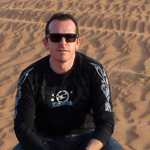

 Prof. Sotirios Kokkalas
Prof. Sotirios Kokkalas Sotirios Kokkalas is currently an Assoc. Professor of Structural Geology at the Petroleum Institute (Abu Dhabi-UAE). Prior that appointment and for more than ten years, he lectured and conducted research on the brittle deformation of the upper crust at the Geology Department in the University of Patras (Greece), where he led several field trips on various tectonic settings. He has published several articles in international journals and conferences on various research subjects such as, fracture and fault zone analysis, stress analysis, strain analysis on shear zones, orogenic deformation, active tectonics and paleoseismology. His current research interest focuses in the area of brittle faulting and fracturing in the upper crust with applications to the oil and gas industry. He is member of several professional organizations (GSA, AGU, EAGE).
Natural fractures are increasingly recognized as an important factor in the exploration and production of hydrocarbons. Fracturing increases the porosity and, more importantly, the permeability in otherwise tight reservoirs, and also enhances the connectivity between different reservoirs units within a field. To successfully predict fracture orientations, lengths, and densities in the subsurface, developing surface analog models of fracture patterns in reservoirs is necessary. Ideal analogs for the calibration of reservoir models should contain representative fracture properties across as wide a range of scales as possible. Extensive areas of high quality outcrops are often ideally suited to allow fracture network characterization at scales from thin section and hand sample, up to many kilometres.
Capturing fracture data across multiple scales requires a range of different methods and appropriate technologies. Direct methods of field measurement, along 1D transects, remain an essential way to study detailed fracture characteristics such as aperture, fill, fracture morphology, mode, kinematics, and relative timing of fracture development. Relatively modern methods of digital acquisition, including terrestrial LiDAR and photogrammetry (from UAV or ground-based), are particularly proficient at capturing rapidly detailed geometrical and geospatial attributes over wide areas, resulting in multiple, longer 1D transects, and 2D-3D surface datasets, including from inaccessible areas of outcrops. This tends to give more robust datasets over a larger scale-range, particularly for fracture heights, lengths, spacing, clustering, termination and connectivity.
These concepts are illustrated with field examples from carbonate reservoir analogs in UAE. Combined datasets from multiple outcrops at different structural positions across the hydrocarbon trap can provide a much larger, multi-scale fracture model that is the basis for a full-field discrete fracture model of kilometre in size.